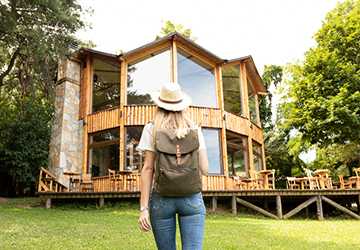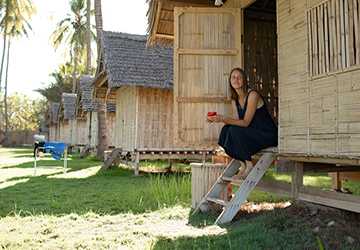The trend of living in small homes, often referred to as "tiny homes," has seen a significant surge in popularity recently. These compact dwellings offer a refreshing, minimalist, and environmentally conscious alternative to conventional housing. But tiny homes are more than just about reducing living space. They symbolize a conscious lifestyle choice that values simplicity, sustainability, and liberation from the weight of owning too many things. This article will be your comprehensive guide, helping you navigate the fascinating world of tiny home living.

Understand the Tiny Home Lifestyle
Before you embark on your tiny home journey, it's essential to understand what the lifestyle entails. Tiny homes are typically between 100 and 400 square feet, significantly smaller than the average American home. This means you'll need to declutter and simplify your life substantially.
Define Your Purpose and Goals
Defining your purpose and goals is one of the first steps to diving into tiny home living. Why do you want to live in a small home? Is it to reduce your carbon footprint, save money, or simplify your life? Understanding your motivations will help you make informed decisions throughout the process.
Research Tiny Home Styles and Designs
Tiny homes come in various styles and designs, from rustic cabins to sleek, modern structures. Take the time to research different designs and layouts to find one that suits your needs and preferences. Consider factors like the number of occupants, storage space, and whether you want a mobile or stationary tiny home.
Set a Budget
Creating a budget is a crucial step in any housing transition. While tiny homes can be more affordable than traditional houses, costs vary significantly depending on location, size, and amenities. Determine your budget early on and stick to it to avoid financial stress.
Choose the Right Location
The location of your tiny home can significantly impact your experience. Some people opt for rural settings, while others prefer urban environments or mobile small homes that allow them to travel. Consider your lifestyle and preferences when selecting the right location for your tiny home.
Legal Considerations
Tiny home living comes with legal considerations, and regulations vary from place to place. Some areas have zoning laws that restrict the construction and placement of small homes. Research local regulations and permitting requirements to ensure your tiny home complies with the law.
Downsizing and Decluttering
Transitioning to a tiny home involves significantly reducing and organizing your belongings. This freeing process prompts you to discard unnecessary items, allowing you to concentrate on what's truly important. Be ready to say goodbye to items with sentimental value, and think about selling, donating, or storing the remaining items.
Building or Buying Your Tiny Home
Once you've researched and are ready to take the plunge, you can either build your tiny home or purchase a pre-built one. Creating your own tiny home allows for customization and creative expression while buying a pre-built one offers convenience and saves time. Ensure your chosen option aligns with your skills, budget, and timeline.
Eco-Friendly Considerations
Many people are drawn to tiny home living for its eco-friendly aspects. Smaller homes require less energy to heat and cool, and they often incorporate sustainable materials and practices. Explore eco-friendly options such as solar panels, composting toilets, and rainwater harvesting systems to reduce environmental impact.
Efficient Space Utilization
Maximizing space utilization is essential in a tiny home. Consider multifunctional furniture, built-in storage, and innovative design solutions to maximize your limited space. Think vertically, use hidden storage compartments, and prioritize functionality without sacrificing comfort.

Embrace a Minimalist Lifestyle
Living in a tiny home promotes a minimalist lifestyle, emphasizing the importance of owning less and cherishing experiences over material possessions. This shift in mindset is not just about having fewer things but about appreciating the simplicity and freedom that comes with it. It's about understanding that less can be more and that our lives can be rich with experiences, not things.
Adapt to a Smaller Footprint
Indeed, residing in a tiny home does require specific adjustments. It necessitates a heightened awareness of your resource usage, adopting efficient practices, and adapting to a more confined living area. This isn't just about downsizing; it's about making mindful choices that not only benefit you but also have a positive impact on the environment.
Stay Organized
Keeping your tiny home organized is crucial to maintaining a comfortable living environment. Develop daily routines for tidying up and utilize storage solutions that work for you. Regularly assess your belongings to prevent clutter from creeping back into your life.
Community and Support
The tiny home community is a tight-knit and supportive network of like-minded individuals. Connect with others who have embraced this lifestyle to share experiences, tips, and challenges. Online forums, social media groups, and local meetups can be valuable resources.
Plan for Utilities
Tiny homes often rely on alternative utilities, such as composting toilets, off-grid power sources, and water conservation systems. Understand the utility requirements of your small home and plan accordingly to ensure a comfortable and sustainable living experience.
Safety and Security
Despite their quaint and cozy appeal, tiny homes, like any other dwelling, require adequate security. Investing in robust locks and installing smoke detectors, among other safety features, is crucial. These precautions will help ensure the protection of both your home and your loved ones. Remember, a secure home is a happy home.
Transitioning to Tiny Home Living
Transitioning to tiny home living may come with a few challenges, but it's a rewarding journey toward a more intentional and sustainable lifestyle. Remember that the journey is as important as the destination and be open to learning and adapting along the way.
Conclusion:
Diving into tiny home living is a life-changing decision that can lead to greater financial freedom, reduced environmental impact, and a deeper connection to what truly matters. You can confidently embark on this adventure by understanding the lifestyle, setting clear goals, and making informed decisions. Whether you build or buy your tiny home, prioritize eco-friendly practices, or embrace a minimalist mindset, the journey of small home living is a transformative experience that offers endless possibilities for a more intentional and fulfilling life. Your journey starts here.





